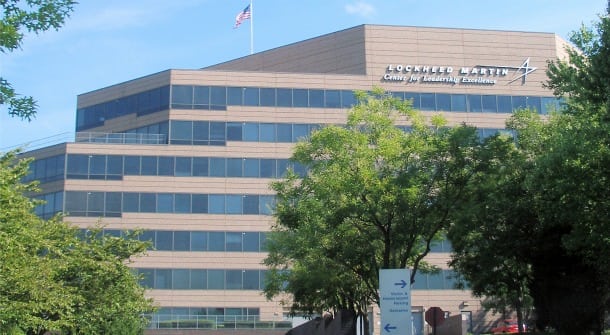Anticipated Pandemic Impacts Send Lockheed Martin’s Earnings and Sales Down in Q1

Lockheed Martin headquarters in Bethesda, Md. Photo: Lockheed Martin
Lockheed Martin on Tuesday posted declines in its top and bottom lines in the first quarter due to program transitions and supply chain and operations challenges related to COVID-19.
COVID impacts led Lockheed Martin last fall to reduce its sales outlook for 2021 and 2022 and suggest about 2% growth in 2023.
Net income in the first quarter slipped 6% to $1.7 billion, $6.44 earnings per share (EPS), from $1.8 billion ($6.56 EPS) a year ago, topping consensus estimates by 22 cents per share. Segment operating margin improved 30 basis points to 11.1%.
Sales in the quarter slid 8% to $15 billion from $16.3 billion a year ago.
The company also left its guidance for 2022 intact, with sales forecast to be around $66 billion and earnings about $26.70 per share. Free cash flow is expected to be at least $6 billion. Lockheed Martin also previously projected about 2% sales growth in 2023.
But since last fall, things have changed. Russia’s invasion of Ukraine in February means the “world’s clearly changed,” boosting the importance of “deterrence” to heights not seen since the mid-20th Century, James Taiclet, Lockheed Martin’s chairman, president and CEO, said during the company’s earnings call. It’s too early to quantify what increased demand might be for defense products as a result of the war in Ukraine but Germany’s recent decision to purchase the company’s F-35 fifth-generation fighter is one benefit, he said. Taiclet also said that there could be increased demand for the company’s upgraded F-16 fighters.
Some analysts on the earnings call also highlighted that the Biden administration’s fiscal year budget request for the Defense Department is higher than the FY ’22 enacted budget, which was generously enlarged by Congress. Richard Safran, an analyst with Seaport Global Securities, asked if the outlook for 2023 is better than expected if the FY ’23 request is approved as is.
Jay Malave, Lockheed Martin’s chief financial officer, agreed that the FY ’22 budget and FY ’23 request are “beneficial” and the “trends are favorable” and are “biased to the upside,” adding that “you would expect it to be incremental from the low single digit baseline that we’d previously provided.” The company is still sorting through the budgets to understand the impacts.
Taiclet later said regardless whether there is new international business or strong U.S. congressional defense appropriations, it can take one to three years to book the sales depending on the program.
In the quarter, the Space, Rotary and Mission Systems, and Missiles and Fire Control segments all struggled with double-digit sales declines driven by a number of programs, including the United Kingdom’s nationalization of a nuclear weapons development facility that Lockheed Martin had been a part owner in until June 2021. Some of other programs that contributed to the revenue drop include commercial space, air and missile defense systems, the UH-60 Black Hawk and presidential helicopters, Littoral Combat Ship and Aegis system, hypersonics, the Army Tactical Missile System and a Special Operations Forces logistical support contract.
The Space segment posted 2.6 million in revenue in Q1, down 15% compared to Q1 in 2021. The company said there was about $95 million revenue decrease for commercial civil space programs due to lower volume on the Orion and Human Lander System (HLS) programs. These decreases were partially offset by higher net sales of about $100 million for strategic and missile defense programs due to higher development volume on the Next Generation Interceptor (NGI) program.
This article was originally published by Via Satellite sister outlet Defense Daily.